Illness Narratives: Exploring Insights, Theory, and Methodology
VerifiedAdded on 2023/01/09
|9
|3705
|47
Essay
AI Summary
This essay provides a comprehensive analysis of illness narratives, examining their theory, methodology, and key elements. It begins by introducing illness narratives as a means of understanding disease emotionally and interactively, particularly in the context of incurable diseases and their impact on individuals' lives. The essay explores the historical context of illness narratives, highlighting the shift in the 1970s towards patient voices and the democratization of medicine. It delves into the theoretical frameworks, drawing on human information science and the sociology of knowledge to understand how narratives are constructed and how they shape our understanding of the world. The methodology of illness narratives, including the use of interviews and ethnographic conversations, is discussed. Furthermore, the essay examines various elements of illness narratives, such as patient beliefs, the role of memory and time, the question of 'Why me?', and moral assessments. It underscores the importance of these narratives in capturing and managing life-vulnerable structures and the ways in which they change across different contexts. The essay concludes by emphasizing the significance of illness narratives in providing insights into the social reality of disease and patient experiences.
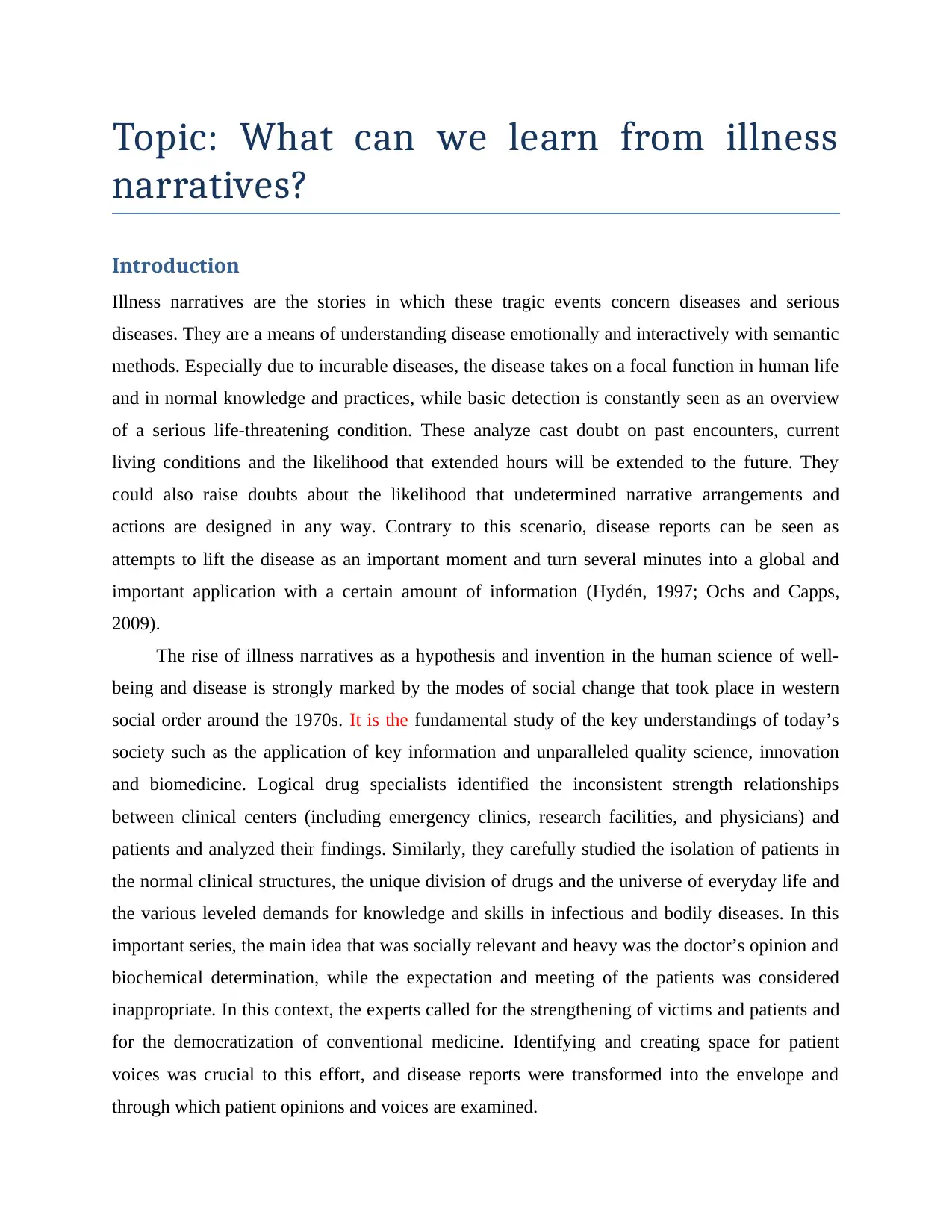
Topic: What can we learn from illness
narratives?
Introduction
Illness narratives are the stories in which these tragic events concern diseases and serious
diseases. They are a means of understanding disease emotionally and interactively with semantic
methods. Especially due to incurable diseases, the disease takes on a focal function in human life
and in normal knowledge and practices, while basic detection is constantly seen as an overview
of a serious life-threatening condition. These analyze cast doubt on past encounters, current
living conditions and the likelihood that extended hours will be extended to the future. They
could also raise doubts about the likelihood that undetermined narrative arrangements and
actions are designed in any way. Contrary to this scenario, disease reports can be seen as
attempts to lift the disease as an important moment and turn several minutes into a global and
important application with a certain amount of information (Hydén, 1997; Ochs and Capps,
2009).
The rise of illness narratives as a hypothesis and invention in the human science of well-
being and disease is strongly marked by the modes of social change that took place in western
social order around the 1970s. It is the fundamental study of the key understandings of today’s
society such as the application of key information and unparalleled quality science, innovation
and biomedicine. Logical drug specialists identified the inconsistent strength relationships
between clinical centers (including emergency clinics, research facilities, and physicians) and
patients and analyzed their findings. Similarly, they carefully studied the isolation of patients in
the normal clinical structures, the unique division of drugs and the universe of everyday life and
the various leveled demands for knowledge and skills in infectious and bodily diseases. In this
important series, the main idea that was socially relevant and heavy was the doctor’s opinion and
biochemical determination, while the expectation and meeting of the patients was considered
inappropriate. In this context, the experts called for the strengthening of victims and patients and
for the democratization of conventional medicine. Identifying and creating space for patient
voices was crucial to this effort, and disease reports were transformed into the envelope and
through which patient opinions and voices are examined.
narratives?
Introduction
Illness narratives are the stories in which these tragic events concern diseases and serious
diseases. They are a means of understanding disease emotionally and interactively with semantic
methods. Especially due to incurable diseases, the disease takes on a focal function in human life
and in normal knowledge and practices, while basic detection is constantly seen as an overview
of a serious life-threatening condition. These analyze cast doubt on past encounters, current
living conditions and the likelihood that extended hours will be extended to the future. They
could also raise doubts about the likelihood that undetermined narrative arrangements and
actions are designed in any way. Contrary to this scenario, disease reports can be seen as
attempts to lift the disease as an important moment and turn several minutes into a global and
important application with a certain amount of information (Hydén, 1997; Ochs and Capps,
2009).
The rise of illness narratives as a hypothesis and invention in the human science of well-
being and disease is strongly marked by the modes of social change that took place in western
social order around the 1970s. It is the fundamental study of the key understandings of today’s
society such as the application of key information and unparalleled quality science, innovation
and biomedicine. Logical drug specialists identified the inconsistent strength relationships
between clinical centers (including emergency clinics, research facilities, and physicians) and
patients and analyzed their findings. Similarly, they carefully studied the isolation of patients in
the normal clinical structures, the unique division of drugs and the universe of everyday life and
the various leveled demands for knowledge and skills in infectious and bodily diseases. In this
important series, the main idea that was socially relevant and heavy was the doctor’s opinion and
biochemical determination, while the expectation and meeting of the patients was considered
inappropriate. In this context, the experts called for the strengthening of victims and patients and
for the democratization of conventional medicine. Identifying and creating space for patient
voices was crucial to this effort, and disease reports were transformed into the envelope and
through which patient opinions and voices are examined.
Paraphrase This Document
Need a fresh take? Get an instant paraphrase of this document with our AI Paraphraser
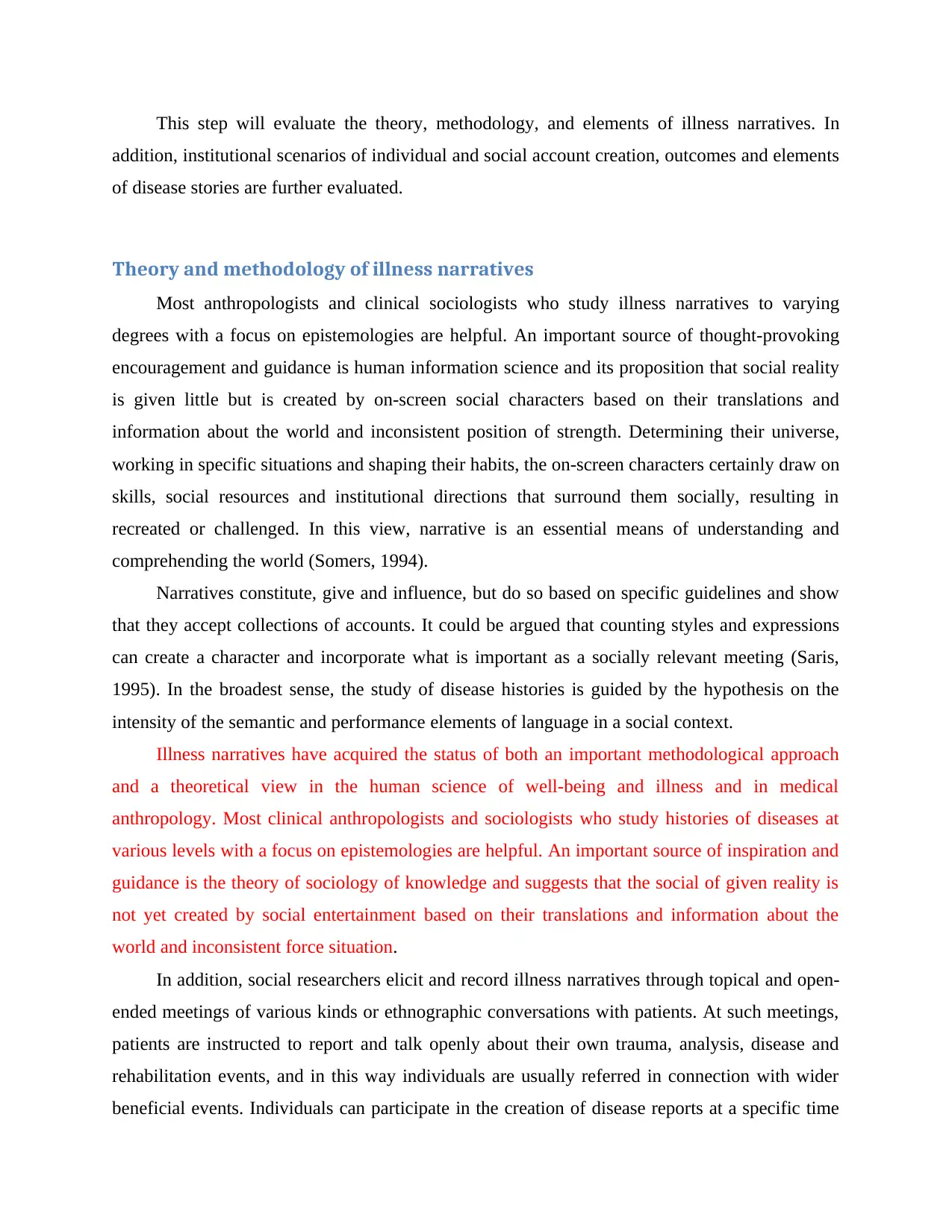
This step will evaluate the theory, methodology, and elements of illness narratives. In
addition, institutional scenarios of individual and social account creation, outcomes and elements
of disease stories are further evaluated.
Theory and methodology of illness narratives
Most anthropologists and clinical sociologists who study illness narratives to varying
degrees with a focus on epistemologies are helpful. An important source of thought-provoking
encouragement and guidance is human information science and its proposition that social reality
is given little but is created by on-screen social characters based on their translations and
information about the world and inconsistent position of strength. Determining their universe,
working in specific situations and shaping their habits, the on-screen characters certainly draw on
skills, social resources and institutional directions that surround them socially, resulting in
recreated or challenged. In this view, narrative is an essential means of understanding and
comprehending the world (Somers, 1994).
Narratives constitute, give and influence, but do so based on specific guidelines and show
that they accept collections of accounts. It could be argued that counting styles and expressions
can create a character and incorporate what is important as a socially relevant meeting (Saris,
1995). In the broadest sense, the study of disease histories is guided by the hypothesis on the
intensity of the semantic and performance elements of language in a social context.
Illness narratives have acquired the status of both an important methodological approach
and a theoretical view in the human science of well-being and illness and in medical
anthropology. Most clinical anthropologists and sociologists who study histories of diseases at
various levels with a focus on epistemologies are helpful. An important source of inspiration and
guidance is the theory of sociology of knowledge and suggests that the social of given reality is
not yet created by social entertainment based on their translations and information about the
world and inconsistent force situation.
In addition, social researchers elicit and record illness narratives through topical and open-
ended meetings of various kinds or ethnographic conversations with patients. At such meetings,
patients are instructed to report and talk openly about their own trauma, analysis, disease and
rehabilitation events, and in this way individuals are usually referred in connection with wider
beneficial events. Individuals can participate in the creation of disease reports at a specific time
addition, institutional scenarios of individual and social account creation, outcomes and elements
of disease stories are further evaluated.
Theory and methodology of illness narratives
Most anthropologists and clinical sociologists who study illness narratives to varying
degrees with a focus on epistemologies are helpful. An important source of thought-provoking
encouragement and guidance is human information science and its proposition that social reality
is given little but is created by on-screen social characters based on their translations and
information about the world and inconsistent position of strength. Determining their universe,
working in specific situations and shaping their habits, the on-screen characters certainly draw on
skills, social resources and institutional directions that surround them socially, resulting in
recreated or challenged. In this view, narrative is an essential means of understanding and
comprehending the world (Somers, 1994).
Narratives constitute, give and influence, but do so based on specific guidelines and show
that they accept collections of accounts. It could be argued that counting styles and expressions
can create a character and incorporate what is important as a socially relevant meeting (Saris,
1995). In the broadest sense, the study of disease histories is guided by the hypothesis on the
intensity of the semantic and performance elements of language in a social context.
Illness narratives have acquired the status of both an important methodological approach
and a theoretical view in the human science of well-being and illness and in medical
anthropology. Most clinical anthropologists and sociologists who study histories of diseases at
various levels with a focus on epistemologies are helpful. An important source of inspiration and
guidance is the theory of sociology of knowledge and suggests that the social of given reality is
not yet created by social entertainment based on their translations and information about the
world and inconsistent force situation.
In addition, social researchers elicit and record illness narratives through topical and open-
ended meetings of various kinds or ethnographic conversations with patients. At such meetings,
patients are instructed to report and talk openly about their own trauma, analysis, disease and
rehabilitation events, and in this way individuals are usually referred in connection with wider
beneficial events. Individuals can participate in the creation of disease reports at a specific time
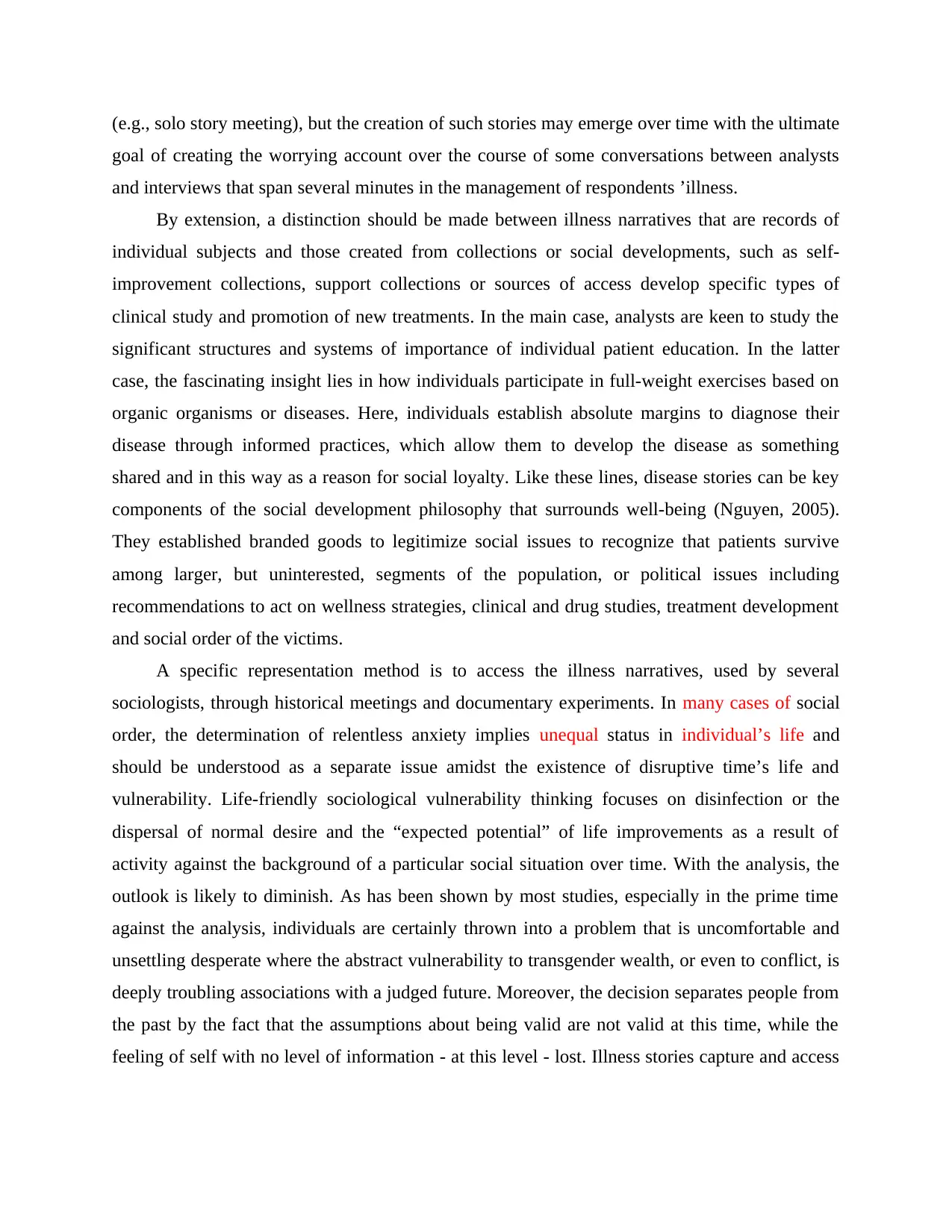
(e.g., solo story meeting), but the creation of such stories may emerge over time with the ultimate
goal of creating the worrying account over the course of some conversations between analysts
and interviews that span several minutes in the management of respondents ’illness.
By extension, a distinction should be made between illness narratives that are records of
individual subjects and those created from collections or social developments, such as self-
improvement collections, support collections or sources of access develop specific types of
clinical study and promotion of new treatments. In the main case, analysts are keen to study the
significant structures and systems of importance of individual patient education. In the latter
case, the fascinating insight lies in how individuals participate in full-weight exercises based on
organic organisms or diseases. Here, individuals establish absolute margins to diagnose their
disease through informed practices, which allow them to develop the disease as something
shared and in this way as a reason for social loyalty. Like these lines, disease stories can be key
components of the social development philosophy that surrounds well-being (Nguyen, 2005).
They established branded goods to legitimize social issues to recognize that patients survive
among larger, but uninterested, segments of the population, or political issues including
recommendations to act on wellness strategies, clinical and drug studies, treatment development
and social order of the victims.
A specific representation method is to access the illness narratives, used by several
sociologists, through historical meetings and documentary experiments. In many cases of social
order, the determination of relentless anxiety implies unequal status in individual’s life and
should be understood as a separate issue amidst the existence of disruptive time’s life and
vulnerability. Life-friendly sociological vulnerability thinking focuses on disinfection or the
dispersal of normal desire and the “expected potential” of life improvements as a result of
activity against the background of a particular social situation over time. With the analysis, the
outlook is likely to diminish. As has been shown by most studies, especially in the prime time
against the analysis, individuals are certainly thrown into a problem that is uncomfortable and
unsettling desperate where the abstract vulnerability to transgender wealth, or even to conflict, is
deeply troubling associations with a judged future. Moreover, the decision separates people from
the past by the fact that the assumptions about being valid are not valid at this time, while the
feeling of self with no level of information - at this level - lost. Illness stories capture and access
goal of creating the worrying account over the course of some conversations between analysts
and interviews that span several minutes in the management of respondents ’illness.
By extension, a distinction should be made between illness narratives that are records of
individual subjects and those created from collections or social developments, such as self-
improvement collections, support collections or sources of access develop specific types of
clinical study and promotion of new treatments. In the main case, analysts are keen to study the
significant structures and systems of importance of individual patient education. In the latter
case, the fascinating insight lies in how individuals participate in full-weight exercises based on
organic organisms or diseases. Here, individuals establish absolute margins to diagnose their
disease through informed practices, which allow them to develop the disease as something
shared and in this way as a reason for social loyalty. Like these lines, disease stories can be key
components of the social development philosophy that surrounds well-being (Nguyen, 2005).
They established branded goods to legitimize social issues to recognize that patients survive
among larger, but uninterested, segments of the population, or political issues including
recommendations to act on wellness strategies, clinical and drug studies, treatment development
and social order of the victims.
A specific representation method is to access the illness narratives, used by several
sociologists, through historical meetings and documentary experiments. In many cases of social
order, the determination of relentless anxiety implies unequal status in individual’s life and
should be understood as a separate issue amidst the existence of disruptive time’s life and
vulnerability. Life-friendly sociological vulnerability thinking focuses on disinfection or the
dispersal of normal desire and the “expected potential” of life improvements as a result of
activity against the background of a particular social situation over time. With the analysis, the
outlook is likely to diminish. As has been shown by most studies, especially in the prime time
against the analysis, individuals are certainly thrown into a problem that is uncomfortable and
unsettling desperate where the abstract vulnerability to transgender wealth, or even to conflict, is
deeply troubling associations with a judged future. Moreover, the decision separates people from
the past by the fact that the assumptions about being valid are not valid at this time, while the
feeling of self with no level of information - at this level - lost. Illness stories capture and access
⊘ This is a preview!⊘
Do you want full access?
Subscribe today to unlock all pages.

Trusted by 1+ million students worldwide
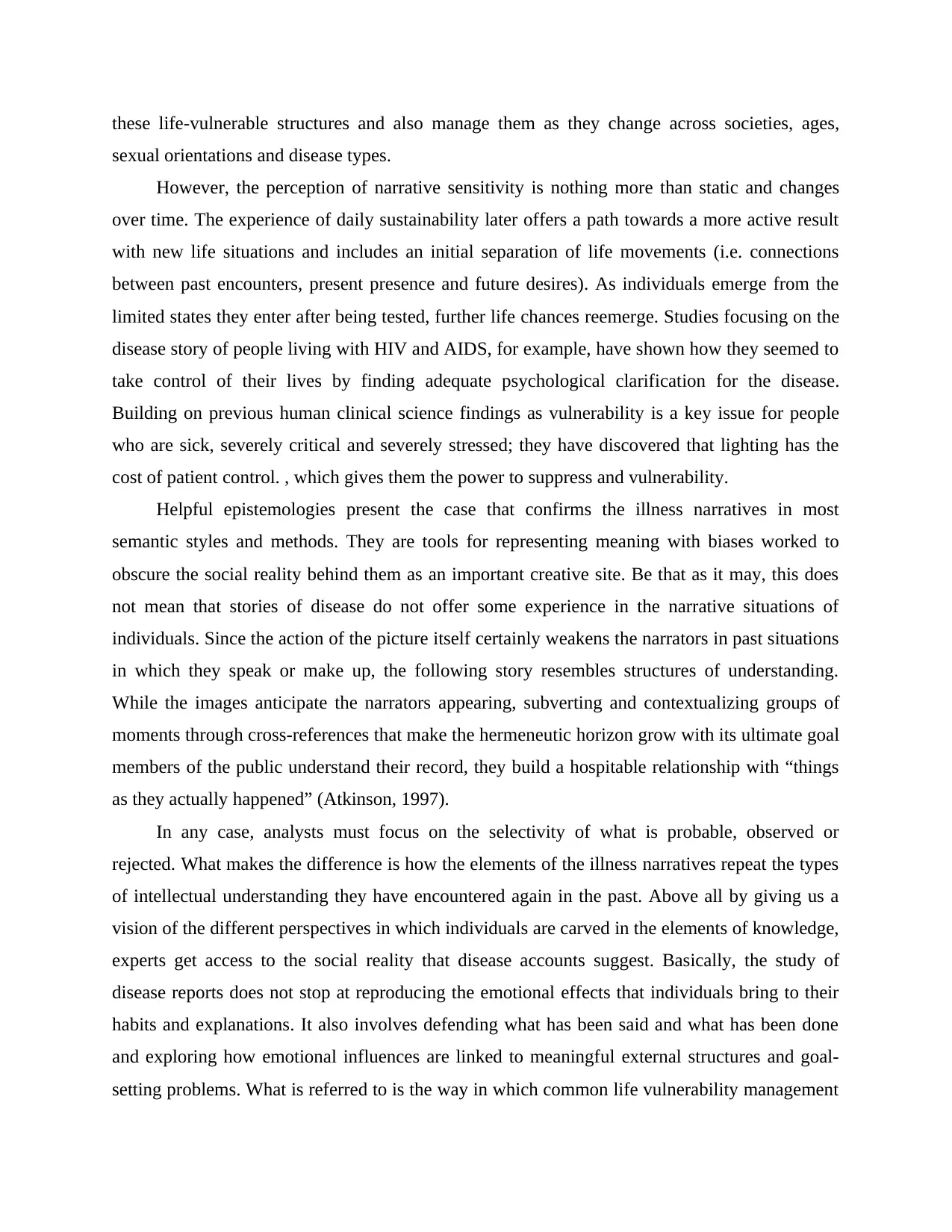
these life-vulnerable structures and also manage them as they change across societies, ages,
sexual orientations and disease types.
However, the perception of narrative sensitivity is nothing more than static and changes
over time. The experience of daily sustainability later offers a path towards a more active result
with new life situations and includes an initial separation of life movements (i.e. connections
between past encounters, present presence and future desires). As individuals emerge from the
limited states they enter after being tested, further life chances reemerge. Studies focusing on the
disease story of people living with HIV and AIDS, for example, have shown how they seemed to
take control of their lives by finding adequate psychological clarification for the disease.
Building on previous human clinical science findings as vulnerability is a key issue for people
who are sick, severely critical and severely stressed; they have discovered that lighting has the
cost of patient control. , which gives them the power to suppress and vulnerability.
Helpful epistemologies present the case that confirms the illness narratives in most
semantic styles and methods. They are tools for representing meaning with biases worked to
obscure the social reality behind them as an important creative site. Be that as it may, this does
not mean that stories of disease do not offer some experience in the narrative situations of
individuals. Since the action of the picture itself certainly weakens the narrators in past situations
in which they speak or make up, the following story resembles structures of understanding.
While the images anticipate the narrators appearing, subverting and contextualizing groups of
moments through cross-references that make the hermeneutic horizon grow with its ultimate goal
members of the public understand their record, they build a hospitable relationship with “things
as they actually happened” (Atkinson, 1997).
In any case, analysts must focus on the selectivity of what is probable, observed or
rejected. What makes the difference is how the elements of the illness narratives repeat the types
of intellectual understanding they have encountered again in the past. Above all by giving us a
vision of the different perspectives in which individuals are carved in the elements of knowledge,
experts get access to the social reality that disease accounts suggest. Basically, the study of
disease reports does not stop at reproducing the emotional effects that individuals bring to their
habits and explanations. It also involves defending what has been said and what has been done
and exploring how emotional influences are linked to meaningful external structures and goal-
setting problems. What is referred to is the way in which common life vulnerability management
sexual orientations and disease types.
However, the perception of narrative sensitivity is nothing more than static and changes
over time. The experience of daily sustainability later offers a path towards a more active result
with new life situations and includes an initial separation of life movements (i.e. connections
between past encounters, present presence and future desires). As individuals emerge from the
limited states they enter after being tested, further life chances reemerge. Studies focusing on the
disease story of people living with HIV and AIDS, for example, have shown how they seemed to
take control of their lives by finding adequate psychological clarification for the disease.
Building on previous human clinical science findings as vulnerability is a key issue for people
who are sick, severely critical and severely stressed; they have discovered that lighting has the
cost of patient control. , which gives them the power to suppress and vulnerability.
Helpful epistemologies present the case that confirms the illness narratives in most
semantic styles and methods. They are tools for representing meaning with biases worked to
obscure the social reality behind them as an important creative site. Be that as it may, this does
not mean that stories of disease do not offer some experience in the narrative situations of
individuals. Since the action of the picture itself certainly weakens the narrators in past situations
in which they speak or make up, the following story resembles structures of understanding.
While the images anticipate the narrators appearing, subverting and contextualizing groups of
moments through cross-references that make the hermeneutic horizon grow with its ultimate goal
members of the public understand their record, they build a hospitable relationship with “things
as they actually happened” (Atkinson, 1997).
In any case, analysts must focus on the selectivity of what is probable, observed or
rejected. What makes the difference is how the elements of the illness narratives repeat the types
of intellectual understanding they have encountered again in the past. Above all by giving us a
vision of the different perspectives in which individuals are carved in the elements of knowledge,
experts get access to the social reality that disease accounts suggest. Basically, the study of
disease reports does not stop at reproducing the emotional effects that individuals bring to their
habits and explanations. It also involves defending what has been said and what has been done
and exploring how emotional influences are linked to meaningful external structures and goal-
setting problems. What is referred to is the way in which common life vulnerability management
Paraphrase This Document
Need a fresh take? Get an instant paraphrase of this document with our AI Paraphraser
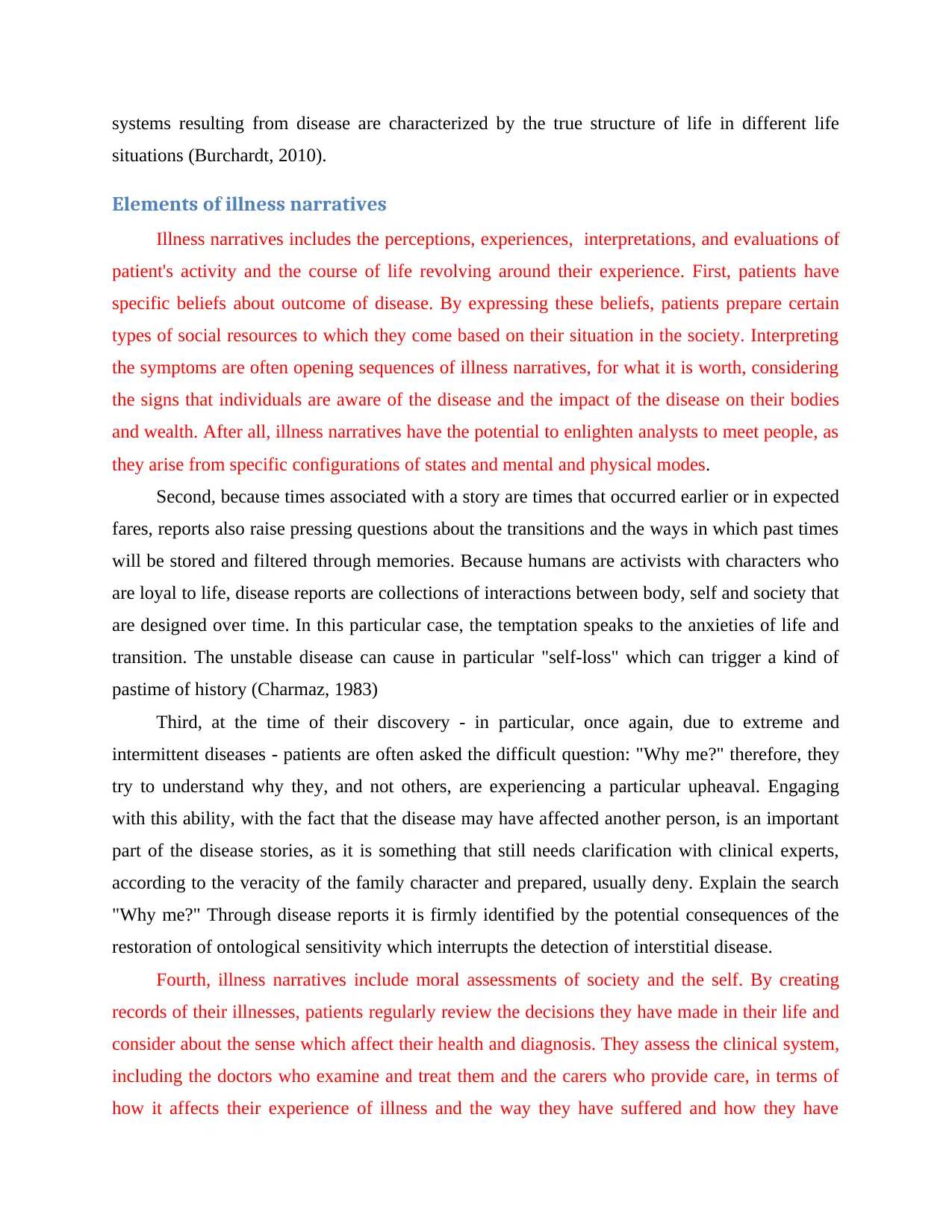
systems resulting from disease are characterized by the true structure of life in different life
situations (Burchardt, 2010).
Elements of illness narratives
Illness narratives includes the perceptions, experiences, interpretations, and evaluations of
patient's activity and the course of life revolving around their experience. First, patients have
specific beliefs about outcome of disease. By expressing these beliefs, patients prepare certain
types of social resources to which they come based on their situation in the society. Interpreting
the symptoms are often opening sequences of illness narratives, for what it is worth, considering
the signs that individuals are aware of the disease and the impact of the disease on their bodies
and wealth. After all, illness narratives have the potential to enlighten analysts to meet people, as
they arise from specific configurations of states and mental and physical modes.
Second, because times associated with a story are times that occurred earlier or in expected
fares, reports also raise pressing questions about the transitions and the ways in which past times
will be stored and filtered through memories. Because humans are activists with characters who
are loyal to life, disease reports are collections of interactions between body, self and society that
are designed over time. In this particular case, the temptation speaks to the anxieties of life and
transition. The unstable disease can cause in particular "self-loss" which can trigger a kind of
pastime of history (Charmaz, 1983)
Third, at the time of their discovery - in particular, once again, due to extreme and
intermittent diseases - patients are often asked the difficult question: "Why me?" therefore, they
try to understand why they, and not others, are experiencing a particular upheaval. Engaging
with this ability, with the fact that the disease may have affected another person, is an important
part of the disease stories, as it is something that still needs clarification with clinical experts,
according to the veracity of the family character and prepared, usually deny. Explain the search
"Why me?" Through disease reports it is firmly identified by the potential consequences of the
restoration of ontological sensitivity which interrupts the detection of interstitial disease.
Fourth, illness narratives include moral assessments of society and the self. By creating
records of their illnesses, patients regularly review the decisions they have made in their life and
consider about the sense which affect their health and diagnosis. They assess the clinical system,
including the doctors who examine and treat them and the carers who provide care, in terms of
how it affects their experience of illness and the way they have suffered and how they have
situations (Burchardt, 2010).
Elements of illness narratives
Illness narratives includes the perceptions, experiences, interpretations, and evaluations of
patient's activity and the course of life revolving around their experience. First, patients have
specific beliefs about outcome of disease. By expressing these beliefs, patients prepare certain
types of social resources to which they come based on their situation in the society. Interpreting
the symptoms are often opening sequences of illness narratives, for what it is worth, considering
the signs that individuals are aware of the disease and the impact of the disease on their bodies
and wealth. After all, illness narratives have the potential to enlighten analysts to meet people, as
they arise from specific configurations of states and mental and physical modes.
Second, because times associated with a story are times that occurred earlier or in expected
fares, reports also raise pressing questions about the transitions and the ways in which past times
will be stored and filtered through memories. Because humans are activists with characters who
are loyal to life, disease reports are collections of interactions between body, self and society that
are designed over time. In this particular case, the temptation speaks to the anxieties of life and
transition. The unstable disease can cause in particular "self-loss" which can trigger a kind of
pastime of history (Charmaz, 1983)
Third, at the time of their discovery - in particular, once again, due to extreme and
intermittent diseases - patients are often asked the difficult question: "Why me?" therefore, they
try to understand why they, and not others, are experiencing a particular upheaval. Engaging
with this ability, with the fact that the disease may have affected another person, is an important
part of the disease stories, as it is something that still needs clarification with clinical experts,
according to the veracity of the family character and prepared, usually deny. Explain the search
"Why me?" Through disease reports it is firmly identified by the potential consequences of the
restoration of ontological sensitivity which interrupts the detection of interstitial disease.
Fourth, illness narratives include moral assessments of society and the self. By creating
records of their illnesses, patients regularly review the decisions they have made in their life and
consider about the sense which affect their health and diagnosis. They assess the clinical system,
including the doctors who examine and treat them and the carers who provide care, in terms of
how it affects their experience of illness and the way they have suffered and how they have
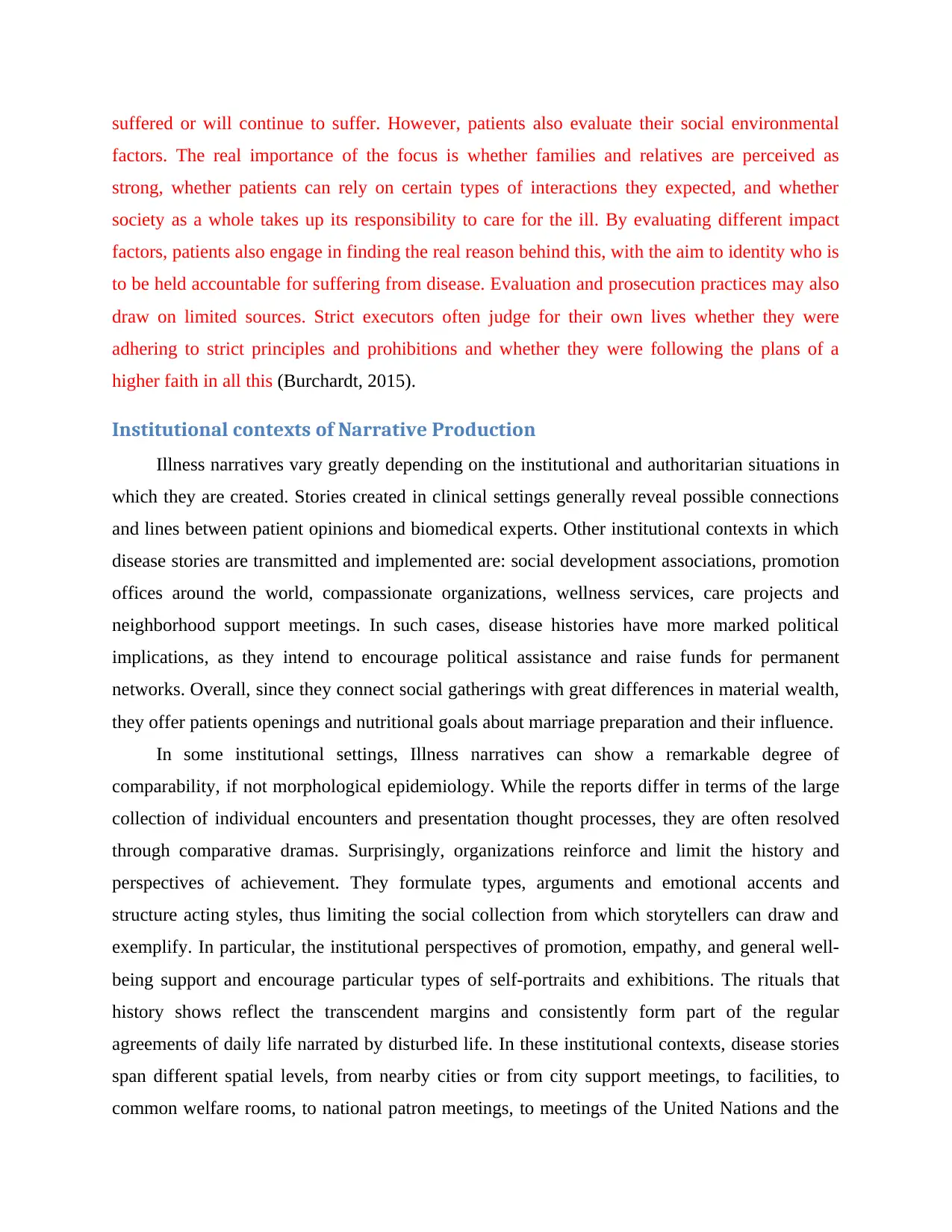
suffered or will continue to suffer. However, patients also evaluate their social environmental
factors. The real importance of the focus is whether families and relatives are perceived as
strong, whether patients can rely on certain types of interactions they expected, and whether
society as a whole takes up its responsibility to care for the ill. By evaluating different impact
factors, patients also engage in finding the real reason behind this, with the aim to identity who is
to be held accountable for suffering from disease. Evaluation and prosecution practices may also
draw on limited sources. Strict executors often judge for their own lives whether they were
adhering to strict principles and prohibitions and whether they were following the plans of a
higher faith in all this (Burchardt, 2015).
Institutional contexts of Narrative Production
Illness narratives vary greatly depending on the institutional and authoritarian situations in
which they are created. Stories created in clinical settings generally reveal possible connections
and lines between patient opinions and biomedical experts. Other institutional contexts in which
disease stories are transmitted and implemented are: social development associations, promotion
offices around the world, compassionate organizations, wellness services, care projects and
neighborhood support meetings. In such cases, disease histories have more marked political
implications, as they intend to encourage political assistance and raise funds for permanent
networks. Overall, since they connect social gatherings with great differences in material wealth,
they offer patients openings and nutritional goals about marriage preparation and their influence.
In some institutional settings, Illness narratives can show a remarkable degree of
comparability, if not morphological epidemiology. While the reports differ in terms of the large
collection of individual encounters and presentation thought processes, they are often resolved
through comparative dramas. Surprisingly, organizations reinforce and limit the history and
perspectives of achievement. They formulate types, arguments and emotional accents and
structure acting styles, thus limiting the social collection from which storytellers can draw and
exemplify. In particular, the institutional perspectives of promotion, empathy, and general well-
being support and encourage particular types of self-portraits and exhibitions. The rituals that
history shows reflect the transcendent margins and consistently form part of the regular
agreements of daily life narrated by disturbed life. In these institutional contexts, disease stories
span different spatial levels, from nearby cities or from city support meetings, to facilities, to
common welfare rooms, to national patron meetings, to meetings of the United Nations and the
factors. The real importance of the focus is whether families and relatives are perceived as
strong, whether patients can rely on certain types of interactions they expected, and whether
society as a whole takes up its responsibility to care for the ill. By evaluating different impact
factors, patients also engage in finding the real reason behind this, with the aim to identity who is
to be held accountable for suffering from disease. Evaluation and prosecution practices may also
draw on limited sources. Strict executors often judge for their own lives whether they were
adhering to strict principles and prohibitions and whether they were following the plans of a
higher faith in all this (Burchardt, 2015).
Institutional contexts of Narrative Production
Illness narratives vary greatly depending on the institutional and authoritarian situations in
which they are created. Stories created in clinical settings generally reveal possible connections
and lines between patient opinions and biomedical experts. Other institutional contexts in which
disease stories are transmitted and implemented are: social development associations, promotion
offices around the world, compassionate organizations, wellness services, care projects and
neighborhood support meetings. In such cases, disease histories have more marked political
implications, as they intend to encourage political assistance and raise funds for permanent
networks. Overall, since they connect social gatherings with great differences in material wealth,
they offer patients openings and nutritional goals about marriage preparation and their influence.
In some institutional settings, Illness narratives can show a remarkable degree of
comparability, if not morphological epidemiology. While the reports differ in terms of the large
collection of individual encounters and presentation thought processes, they are often resolved
through comparative dramas. Surprisingly, organizations reinforce and limit the history and
perspectives of achievement. They formulate types, arguments and emotional accents and
structure acting styles, thus limiting the social collection from which storytellers can draw and
exemplify. In particular, the institutional perspectives of promotion, empathy, and general well-
being support and encourage particular types of self-portraits and exhibitions. The rituals that
history shows reflect the transcendent margins and consistently form part of the regular
agreements of daily life narrated by disturbed life. In these institutional contexts, disease stories
span different spatial levels, from nearby cities or from city support meetings, to facilities, to
common welfare rooms, to national patron meetings, to meetings of the United Nations and the
⊘ This is a preview!⊘
Do you want full access?
Subscribe today to unlock all pages.

Trusted by 1+ million students worldwide
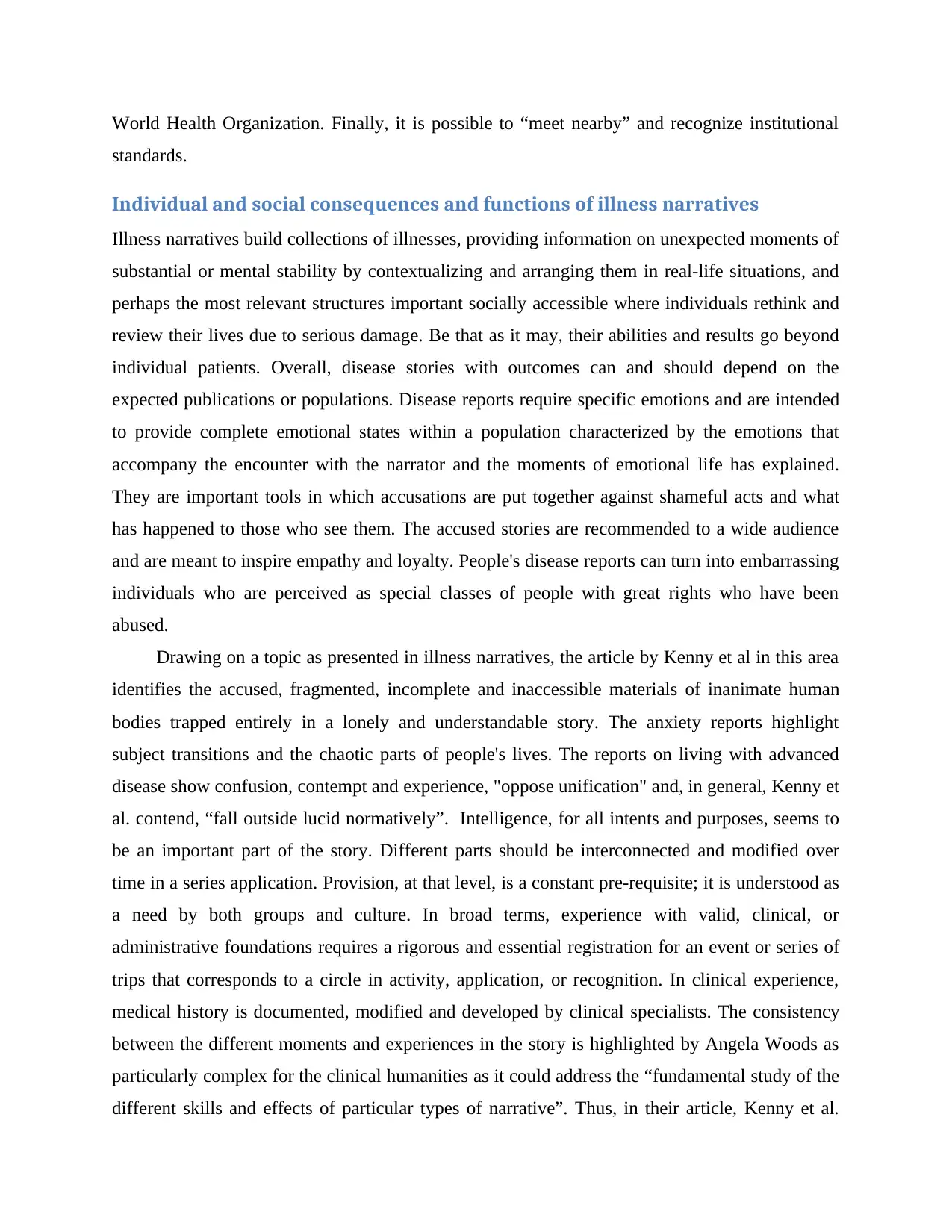
World Health Organization. Finally, it is possible to “meet nearby” and recognize institutional
standards.
Individual and social consequences and functions of illness narratives
Illness narratives build collections of illnesses, providing information on unexpected moments of
substantial or mental stability by contextualizing and arranging them in real-life situations, and
perhaps the most relevant structures important socially accessible where individuals rethink and
review their lives due to serious damage. Be that as it may, their abilities and results go beyond
individual patients. Overall, disease stories with outcomes can and should depend on the
expected publications or populations. Disease reports require specific emotions and are intended
to provide complete emotional states within a population characterized by the emotions that
accompany the encounter with the narrator and the moments of emotional life has explained.
They are important tools in which accusations are put together against shameful acts and what
has happened to those who see them. The accused stories are recommended to a wide audience
and are meant to inspire empathy and loyalty. People's disease reports can turn into embarrassing
individuals who are perceived as special classes of people with great rights who have been
abused.
Drawing on a topic as presented in illness narratives, the article by Kenny et al in this area
identifies the accused, fragmented, incomplete and inaccessible materials of inanimate human
bodies trapped entirely in a lonely and understandable story. The anxiety reports highlight
subject transitions and the chaotic parts of people's lives. The reports on living with advanced
disease show confusion, contempt and experience, "oppose unification" and, in general, Kenny et
al. contend, “fall outside lucid normatively”. Intelligence, for all intents and purposes, seems to
be an important part of the story. Different parts should be interconnected and modified over
time in a series application. Provision, at that level, is a constant pre-requisite; it is understood as
a need by both groups and culture. In broad terms, experience with valid, clinical, or
administrative foundations requires a rigorous and essential registration for an event or series of
trips that corresponds to a circle in activity, application, or recognition. In clinical experience,
medical history is documented, modified and developed by clinical specialists. The consistency
between the different moments and experiences in the story is highlighted by Angela Woods as
particularly complex for the clinical humanities as it could address the “fundamental study of the
different skills and effects of particular types of narrative”. Thus, in their article, Kenny et al.
standards.
Individual and social consequences and functions of illness narratives
Illness narratives build collections of illnesses, providing information on unexpected moments of
substantial or mental stability by contextualizing and arranging them in real-life situations, and
perhaps the most relevant structures important socially accessible where individuals rethink and
review their lives due to serious damage. Be that as it may, their abilities and results go beyond
individual patients. Overall, disease stories with outcomes can and should depend on the
expected publications or populations. Disease reports require specific emotions and are intended
to provide complete emotional states within a population characterized by the emotions that
accompany the encounter with the narrator and the moments of emotional life has explained.
They are important tools in which accusations are put together against shameful acts and what
has happened to those who see them. The accused stories are recommended to a wide audience
and are meant to inspire empathy and loyalty. People's disease reports can turn into embarrassing
individuals who are perceived as special classes of people with great rights who have been
abused.
Drawing on a topic as presented in illness narratives, the article by Kenny et al in this area
identifies the accused, fragmented, incomplete and inaccessible materials of inanimate human
bodies trapped entirely in a lonely and understandable story. The anxiety reports highlight
subject transitions and the chaotic parts of people's lives. The reports on living with advanced
disease show confusion, contempt and experience, "oppose unification" and, in general, Kenny et
al. contend, “fall outside lucid normatively”. Intelligence, for all intents and purposes, seems to
be an important part of the story. Different parts should be interconnected and modified over
time in a series application. Provision, at that level, is a constant pre-requisite; it is understood as
a need by both groups and culture. In broad terms, experience with valid, clinical, or
administrative foundations requires a rigorous and essential registration for an event or series of
trips that corresponds to a circle in activity, application, or recognition. In clinical experience,
medical history is documented, modified and developed by clinical specialists. The consistency
between the different moments and experiences in the story is highlighted by Angela Woods as
particularly complex for the clinical humanities as it could address the “fundamental study of the
different skills and effects of particular types of narrative”. Thus, in their article, Kenny et al.
Paraphrase This Document
Need a fresh take? Get an instant paraphrase of this document with our AI Paraphraser
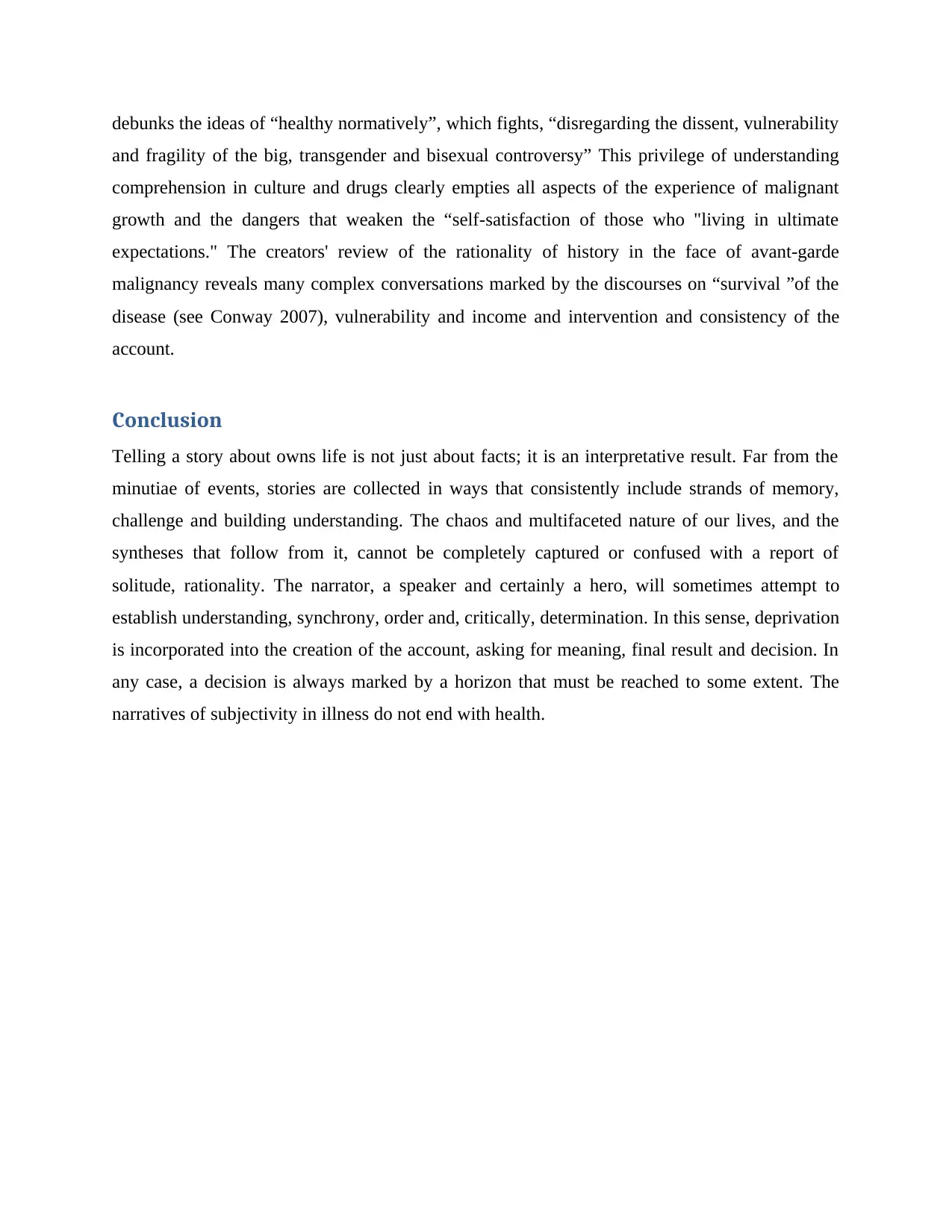
debunks the ideas of “healthy normatively”, which fights, “disregarding the dissent, vulnerability
and fragility of the big, transgender and bisexual controversy” This privilege of understanding
comprehension in culture and drugs clearly empties all aspects of the experience of malignant
growth and the dangers that weaken the “self-satisfaction of those who "living in ultimate
expectations." The creators' review of the rationality of history in the face of avant-garde
malignancy reveals many complex conversations marked by the discourses on “survival ”of the
disease (see Conway 2007), vulnerability and income and intervention and consistency of the
account.
Conclusion
Telling a story about owns life is not just about facts; it is an interpretative result. Far from the
minutiae of events, stories are collected in ways that consistently include strands of memory,
challenge and building understanding. The chaos and multifaceted nature of our lives, and the
syntheses that follow from it, cannot be completely captured or confused with a report of
solitude, rationality. The narrator, a speaker and certainly a hero, will sometimes attempt to
establish understanding, synchrony, order and, critically, determination. In this sense, deprivation
is incorporated into the creation of the account, asking for meaning, final result and decision. In
any case, a decision is always marked by a horizon that must be reached to some extent. The
narratives of subjectivity in illness do not end with health.
and fragility of the big, transgender and bisexual controversy” This privilege of understanding
comprehension in culture and drugs clearly empties all aspects of the experience of malignant
growth and the dangers that weaken the “self-satisfaction of those who "living in ultimate
expectations." The creators' review of the rationality of history in the face of avant-garde
malignancy reveals many complex conversations marked by the discourses on “survival ”of the
disease (see Conway 2007), vulnerability and income and intervention and consistency of the
account.
Conclusion
Telling a story about owns life is not just about facts; it is an interpretative result. Far from the
minutiae of events, stories are collected in ways that consistently include strands of memory,
challenge and building understanding. The chaos and multifaceted nature of our lives, and the
syntheses that follow from it, cannot be completely captured or confused with a report of
solitude, rationality. The narrator, a speaker and certainly a hero, will sometimes attempt to
establish understanding, synchrony, order and, critically, determination. In this sense, deprivation
is incorporated into the creation of the account, asking for meaning, final result and decision. In
any case, a decision is always marked by a horizon that must be reached to some extent. The
narratives of subjectivity in illness do not end with health.
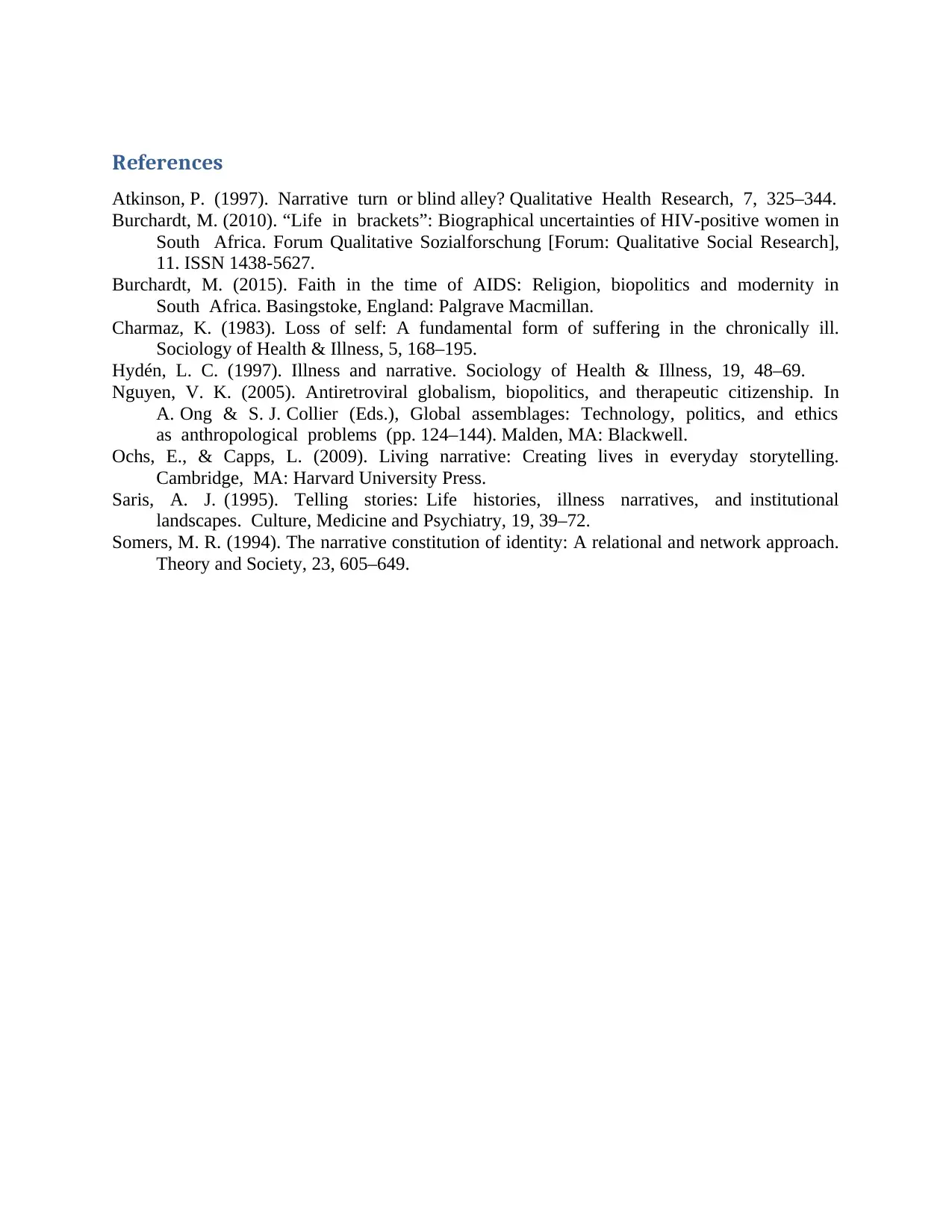
References
Atkinson, P. (1997). Narrative turn or blind alley? Qualitative Health Research, 7, 325–344.
Burchardt, M. (2010). “Life in brackets”: Biographical uncertainties of HIV-positive women in
South Africa. Forum Qualitative Sozialforschung [Forum: Qualitative Social Research],
11. ISSN 1438-5627.
Burchardt, M. (2015). Faith in the time of AIDS: Religion, biopolitics and modernity in
South Africa. Basingstoke, England: Palgrave Macmillan.
Charmaz, K. (1983). Loss of self: A fundamental form of suffering in the chronically ill.
Sociology of Health & Illness, 5, 168–195.
Hydén, L. C. (1997). Illness and narrative. Sociology of Health & Illness, 19, 48–69.
Nguyen, V. K. (2005). Antiretroviral globalism, biopolitics, and therapeutic citizenship. In
A. Ong & S. J. Collier (Eds.), Global assemblages: Technology, politics, and ethics
as anthropological problems (pp. 124–144). Malden, MA: Blackwell.
Ochs, E., & Capps, L. (2009). Living narrative: Creating lives in everyday storytelling.
Cambridge, MA: Harvard University Press.
Saris, A. J. (1995). Telling stories: Life histories, illness narratives, and institutional
landscapes. Culture, Medicine and Psychiatry, 19, 39–72.
Somers, M. R. (1994). The narrative constitution of identity: A relational and network approach.
Theory and Society, 23, 605–649.
Atkinson, P. (1997). Narrative turn or blind alley? Qualitative Health Research, 7, 325–344.
Burchardt, M. (2010). “Life in brackets”: Biographical uncertainties of HIV-positive women in
South Africa. Forum Qualitative Sozialforschung [Forum: Qualitative Social Research],
11. ISSN 1438-5627.
Burchardt, M. (2015). Faith in the time of AIDS: Religion, biopolitics and modernity in
South Africa. Basingstoke, England: Palgrave Macmillan.
Charmaz, K. (1983). Loss of self: A fundamental form of suffering in the chronically ill.
Sociology of Health & Illness, 5, 168–195.
Hydén, L. C. (1997). Illness and narrative. Sociology of Health & Illness, 19, 48–69.
Nguyen, V. K. (2005). Antiretroviral globalism, biopolitics, and therapeutic citizenship. In
A. Ong & S. J. Collier (Eds.), Global assemblages: Technology, politics, and ethics
as anthropological problems (pp. 124–144). Malden, MA: Blackwell.
Ochs, E., & Capps, L. (2009). Living narrative: Creating lives in everyday storytelling.
Cambridge, MA: Harvard University Press.
Saris, A. J. (1995). Telling stories: Life histories, illness narratives, and institutional
landscapes. Culture, Medicine and Psychiatry, 19, 39–72.
Somers, M. R. (1994). The narrative constitution of identity: A relational and network approach.
Theory and Society, 23, 605–649.
⊘ This is a preview!⊘
Do you want full access?
Subscribe today to unlock all pages.

Trusted by 1+ million students worldwide
1 out of 9
Your All-in-One AI-Powered Toolkit for Academic Success.
+13062052269
info@desklib.com
Available 24*7 on WhatsApp / Email
![[object Object]](/_next/static/media/star-bottom.7253800d.svg)
Unlock your academic potential
Copyright © 2020–2025 A2Z Services. All Rights Reserved. Developed and managed by ZUCOL.